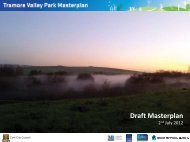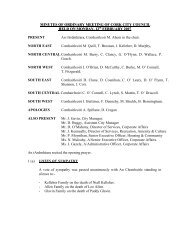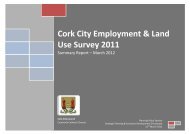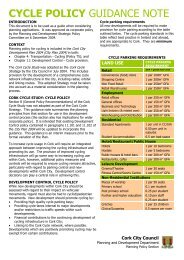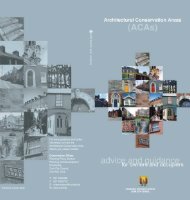Development Plan Chapter 9 Built Heritage - Cork City Council
Development Plan Chapter 9 Built Heritage - Cork City Council
Development Plan Chapter 9 Built Heritage - Cork City Council
Create successful ePaper yourself
Turn your PDF publications into a flip-book with our unique Google optimized e-Paper software.
• • • • • • • • • • • • • • • • •<br />
houses of the city. In these areas, new buildings may not be appropriate, or may require extensive<br />
archaeological excavations in order to obtain maximum archaeological information from the site.<br />
A Survey of the Burial Grounds within <strong>Cork</strong> <strong>City</strong> has been undertaken by <strong>Cork</strong> <strong>City</strong> <strong>Council</strong>.<br />
POLICY 9.15<br />
<strong>Development</strong> on Burial Grounds<br />
The <strong>City</strong> <strong>Council</strong> will seek to protect and enhance historic burial grounds and their settings.<br />
<strong>Development</strong> in and adjacent to these areas will be limited and may also be subject to<br />
archaeological conditions.<br />
Industrial Archaeology<br />
9.28 <strong>Cork</strong>’s development as a significant industrial<br />
centre in the 18th and 19th centuries has created<br />
an important record of historic archaeological<br />
remains still surviving in the contemporary city.<br />
Today many of the buildings that housed the<br />
industries and the associated warehouses, grainstores,<br />
malt-houses, etc. still survive. Many of these<br />
buildings have been demolished in recent years,<br />
some are derelict or ruinous, some are converted<br />
but scarcely recognisable as historic buildings<br />
while an exceptional few have been<br />
sympathetically converted and refurbished.<br />
Associated features, such as millraces, are<br />
particularly vulnerable as they may extend for<br />
considerable distances from the core building.<br />
Intact machinery and fittings rarely survive but<br />
structural elements designed to accommodate<br />
machinery can be extremely informative.<br />
POLICY 9.16<br />
Industrial Archaeology<br />
All development proposals for industrial buildings and sites of industrial archaeological<br />
importance must be accompanied by an archaeological assessment of the building(s) and their<br />
surrounding environment. All development proposals should be designed in sympathy with<br />
existing features and structures.Where in exceptional circumstances demolition is permitted,<br />
a detailed building report will be required.<br />
Protection of Underwater Archaeology<br />
9.29 Under the National Monuments (Amendment) Act 1930-2004 all shipwrecks over one hundred years,<br />
underwater archaeological structures, features and objects are protected. <strong>Cork</strong> was built on estuarine<br />
islands in the marshy valley of the River Lee at a point where it formed a number of waterways.The<br />
marshland areas to the east and west of the medieval city were reclaimed in the eighteenth century. It<br />
is possible that archaeological riverine-related features may survive.These may take the form of walkways,<br />
fish-traps, timber jetties or simple mooring posts.<br />
POLICY 9.17<br />
Underwater Archaeology<br />
All development proposals which will impact on riverine, intertidal and sub-tidal<br />
environments should be accompanied by an archaeological assessment.<br />
99







